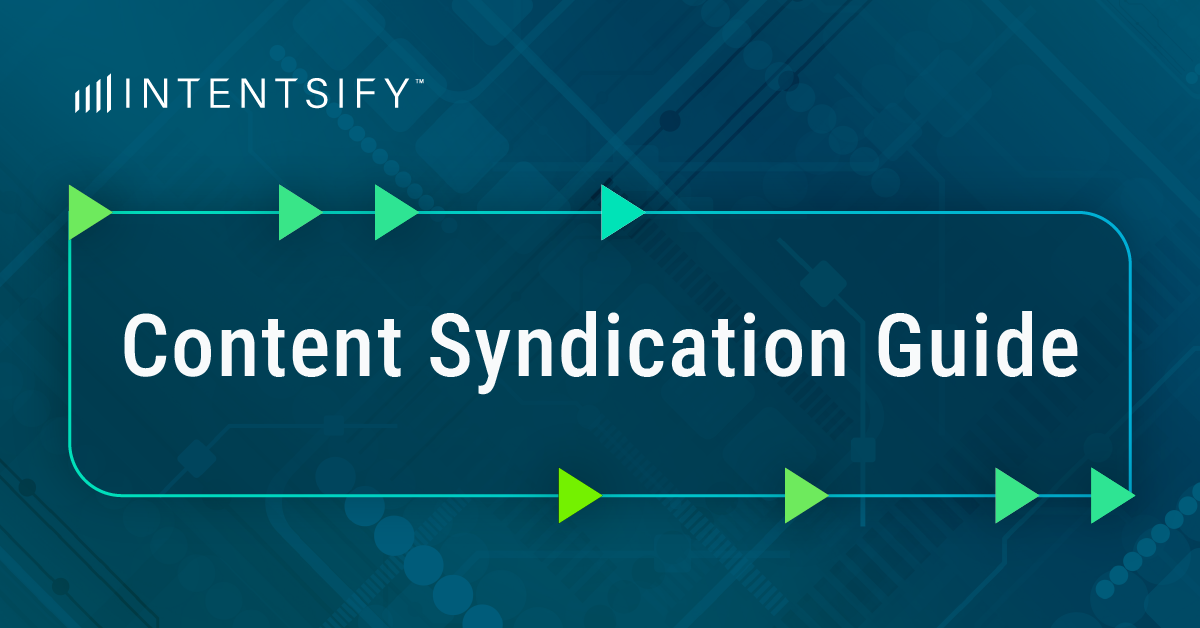You’ve likely worked so hard and invested money and time to create great content, post it on your social pages, and optimize it for search engines. But the views and the subscribers you get is a different story. Don’t worry! Most marketers struggle to get traffic. However, while there are many tactics to boost those numbers, content syndication is one of the best marketing strategies for distributing your B2B content.
So, what is content syndication, and how can you leverage it to fuel your marketing strategy? This guide will walk you through the ins and outs of content syndication, its value to your business, and the steps to building a successful syndication program.
Ready to unlock new opportunities with your content? Let’s dive in.
What Is Content Syndication?
It’s critical to ensure your content is getting in front of the right target audiences—but this becomes harder and harder to achieve (organically) because digital channels are more saturated than ever. To help, marketers have turned towards content syndication—a form of third-party demand generation that leverages media partners to distribute your branded content via various channels to reach broader audiences while acquiring privacy-compliant prospect contact information.
Content syndication is the process of republishing your content on third-party websites. It could be articles, blog posts, whitepapers, eBooks, or infographics. The advantage is two-fold: first, these websites offer readers new content filled with valuable information. Second, you can prolong the reach of your best-performing content by sharing it with wider audiences, which increases your brand’s visibility.
When done effectively, content syndication amplifies your voice in the market, ensuring your expertise reaches potential customers needing help finding your website. But it’s not just about quantity. The key lies in syndicating content on the right platforms that align with your target audience and business objectives.
Types of Content Often Syndicated
- Blog Articles – Thought leadership pieces that offer value to a broad audience
- eBooks and White papers – In-depth guides that help establish your authority in your industry
- Infographics – Visually engaging content that breaks down complex topics into digestible visuals
- Videos – Visual educational or promotional content that captures attention quickly
Why is Content Syndication an Essential Part of a Marketing Strategy?
There are several reasons why content syndication is a must-have in your marketing arsenal. Here are some of them:
1. Increase Access to Target Audience
Content syndication allows marketers to increase the visibility of their content by sharing it on third-party platform and use outbound marketing strategies. By using different data sources, you can strategically place your content in front of millions of audiences to increase visibility and effectiveness.
2. Lead Generation
Publishing gated content on relevant third-party sites can be an effective strategy for generating leads. If you partner with the right platform and use the data to personalize content, you can catch the attention of potential customers.
3. Qualifying the Prospect
Content syndication helps marketers qualify potential customers by tracking engagement and intent data. Connecting content through reputable platforms helps attract more target audience. This allows you to better identify and qualify your target customers based on the topics they engage with.
4. Brand Awareness and Brand Authority
Republishing content on established third-party sites increases brand visibility and strengthens its authority within the industry. Content appearing on reputable platforms makes the company a thought leader. This increases your credibility and helps build trust with your new audience.
5. Traffic increases
You can direct more traffic to your website by including backlinks in syndicated content. It optimizes SEO and helps nurture leads. However, you need to choose publishing partners carefully. This is because each party may have specific policies regarding the number of backlinks allowed, thus affecting the overall traffic generation.
What is Intent-Activated Content Syndication?
Intent-activated content syndication is a more targeted form of syndication that uses intent data to identify prospects actively researching your products or services. It enables you to deliver the right content to the right people at the right time based on their behavioral signals. It identifies which accounts are in an active buy cycle and highlights the content most likely to resonate with those accounts (and at which geo locations)
For example, if a potential buyer is frequently searching for topics related to “intent-based demand generation,” intent-activated content syndication can ensure that your relevant content appears on the platforms they visit, increasing the likelihood of engagement and conversion.
A few ways you can leverage the intent insights include:
- Segmenting intent-identified target accounts into separate campaigns.
- Aligning content assets with prospects’ interests and buyer’s journey stages.
- Select the right combination of engagement tactics and messages for each in-market account.
Benefits of Intent-Activated Content Syndication
- Higher quality leads – Engage prospects with higher buying intent.
- Efficient use of resources – Focus on audiences that are more likely to convert.
- Personalized marketing – You should tailor your content based on specific intent signals to make your message more relevant and impactful.
Foundations of a Successful Content Syndication Program
Creating an effective content syndication strategy requires a structured approach and careful planning. To maximize your results, follow these five foundational steps:
1. Build a Strong Target-Account List (TAL)
The success of your content syndication program begins with defining a well-researched list of target accounts. These companies should:
- Fit your ideal customer profile (ICP) – Use firmographic, technographic, and intent data to identify companies that closely match your ideal customer criteria.
- Be actively researching relevant topics – Ensure that your target accounts are interested in keywords and topics related to your products or solutions. This helps prioritize accounts that are more likely to engage.
Refine your ICPs using intent data to improve the effectiveness of your program. According to the Ascend2 Research Report, 70% of B2B marketers using intent data rate their digital marketing strategies as highly successful, compared to 33% of non-users.
2. Set Strong Persona Targets
Did you know that effective content syndication is more than just targeting the right companies? It’s more about reaching the right people within those companies. Consider the following when setting persona targets:
- Do target multiple job titles to cover different roles with similar interests.
- Do include geographic targeting based on where intent signals are originating.
- Don’t limit your focus to executive titles. Engage decision influencers across various roles.
3. Select the Right Content
Choosing the right content to syndicate is crucial for attracting and engaging your target audience. Your content should:
- Be educational and provide actionable insights
- Offer a solution to a problem relevant to your audience
- Introduce your brand’s unique approach and expertise
When distributing content to media partners, include 3-5 assets per campaign and provide abstracts or summaries for each to make it easier for partners to promote.
4. Verify Leads and Nurture to Sales-Ready
Before handing off leads to your sales team, ensure you’ve implemented processes to verify their quality and readiness. Best practices include:
- Establishing lead verification processes to avoid duplicate, low-quality, or inaccurate leads.
- Using email nurture campaigns to engage leads further and introduce them to your brand and solutions.
- Scoring leads based on engagement metrics and recent intent signals.
5. Analyze Campaign Performance
Continuously monitoring and optimizing your content syndication efforts is essential for long-term success. Here’s how:
- Track the performance of individual content pieces to identify top-performing assets and optimize campaigns accordingly.
- Adjust lead caps based on engagement levels, considering whether to accept more leads from highly engaged accounts.
- Run programmatic ad campaigns targeting accounts from which you’ve already generated leads to improve conversion rates further.
Download the full content syndication infographic for more tips and strategies
Common Pitfalls to Avoid in Content Syndication
Even the best content syndication strategy can fail if not executed correctly. Here are some of the common pitfalls to avoid:
- Choosing the wrong platforms – Syndicating on low-quality or irrelevant sites can damage your brand reputation.
- Ignoring performance metrics – Without monitoring performance, you won’t know what’s working or how to improve.
- Lack of consistency – Sporadic syndication efforts often fail to build momentum. Maintain a consistent presence on selected platforms.
Unlock the Potential of Content Syndication with Intensify
Prioritizing accounts is one thing. Unlocking full visibility into how targeted accounts and personas are engaging with your branded assets is everything. Our content syndication programs reliably convert account-level intent signals into accurate contact information, enabling you to connect with decision makers at in-market accounts who expect your engagement.
Ready to get started? Contact us today to learn more about intent-activated demand generation.
{{cta(‘0e6684f8-364d-40fd-bcd5-57662ba0d15f’)}}






